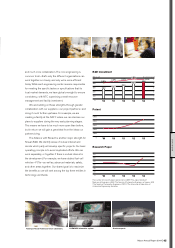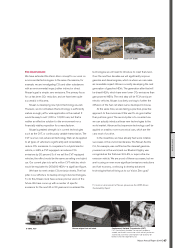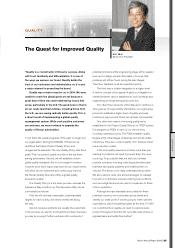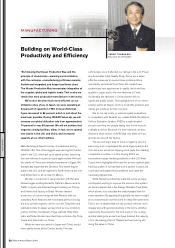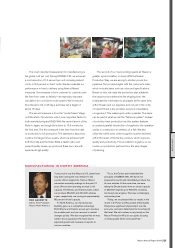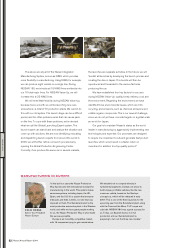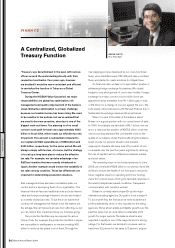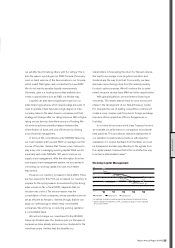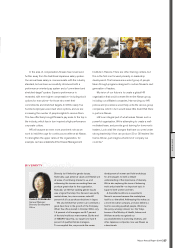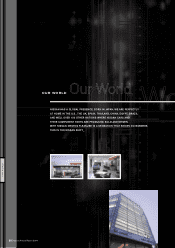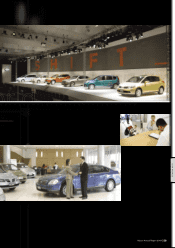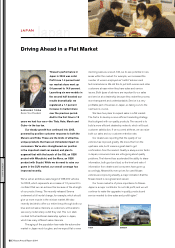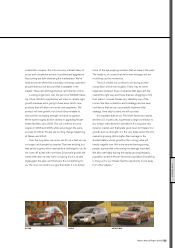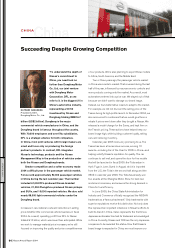Nissan 2005 Annual Report Download - page 57
Download and view the complete annual report
Please find page 57 of the 2005 Nissan annual report below. You can navigate through the pages in the report by either clicking on the pages listed below, or by using the keyword search tool below to find specific information within the annual report.
Nissan Annual Report 2004 55
shareholders in forecasting the return for Nissan’s shares.
We want to encourage more long-term investors, and
dividends are the way to do that. Concurrently, we have
also been repurchasing stock from the market, primarily
for stock option purposes. We will continue this to some
extent, because we may have M&A and other opportunities.
With global expansion, we must extend financing to
new areas. This means that we have to move to a second
phase in the development of our Global Treasury Center.
For example, the use of leading competitive countries will
create a more complex cash flow due to foreign exchange
exposure. We’ve opened an office in Singapore as a
first step.
In our drive to become a world-class Treasury function,
we evaluate our performance in comparison to worldwide
best practices. This provides an objective assessment of
our operation. Investors also provide us with objective
evaluations. To receive feedback from the latter, we must
be transparent, and also pay attention to the signals from
the capital market. I believe that is the most effective way
to enhance shareholders’ value.”
we set after benchmarking others with A+ ratings. This is
also the reason we changed our ROIC formula. Previously,
cash on hand was one of the denominators in our formula,
which meant that higher cash on hand led to lower ROIC.
We do not want to penalize liquidity improvements.
Obviously, cash is a funding source that enables us to
invest in opportunities such as R&D in a flexible way.
Liquidity can also have a significant impact on our
sales financing business, which requires large amounts of
cash to operate. There has been a high degree of inter-
company loans to the sales finance companies, but that
strategy will change after our rating improves. With a higher
rating we can develop diversified sources of funding. We
will strive to achieve a healthy balance between the
diversification of funds and cost efficiencies by utilizing
sound financial management.
In terms of the commitment under NISSAN Value-Up,
we must maintain a 20 percent ROIC on average over the
course of the plan. I believe that Treasury can continue to
play a key role in managing working capital. What we did
especially well under NISSAN 180 was to improve our
supply chain management. With the information from the
new supply chain management system, we succeeded in
converting our working capital into cash much faster
than before.
However, our inventory increased in fiscal 2004. There
are two reasons for this. First, we increased our inventory to
prepare for the spring season. As evidenced by the strong
sales volume so far in fiscal 2005, it appears that our
decision was correct. The second reason was the
consolidation of new companies, whose operations are not
yet as efficient as Nissan’s. I believe, though, that we can
apply our methodology to these newly consolidated
companies. We will focus on reducing working capital on
a consolidated basis.
We will not change our commitment to the NISSAN
Value-Up dividend plan. Our dividend policy is transparent
because we have already announced our dividends for the
next three years. I believe that this benefits our
OUR WORK
10
8
(%)
6
4
2
0’00 ’01 ’02 ’03 ’04
NISSAN Company A Company B
9.0
7.6
5.8 4.0
3.6
3.1*
Working Capital Management
Consolidated automotive working capital/consolidated automotive turnover
* Same scope pf consolidation as P&L, excluding change of cash compared
to fiscal year 2003


